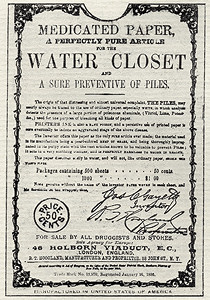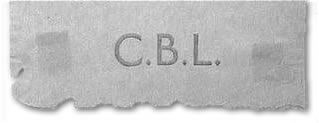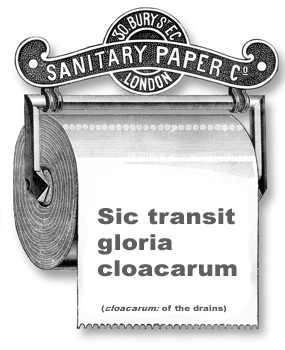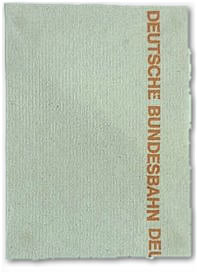 |
|
| News About Us Membership Events Links |
|
This paper is a revised version of the one published in THE EPHEMERIST, December 1990. Ian Maxted introduces a blinkered world to the young academic discipline of cloacopapyrology. The announcement in the national press on 19 October 1989 that Bronco was to discontinue the manufacture of hard toilet paper marked an important stage in the thousand year history of this commodity, a history which cloacopapyrologists are only now beginning to document adequately. In the account which follows I shall use the non-U term "toilet paper" in preference to the U term "lavatory paper" since this is the way it was first designated in trade literature during the Victorian period. It is the Arab writer Abu Zaid Hasan al Siraff (fl. 916) who first described the use of toilet paper in a collection of travels translated into French in 1845 as Relation des voyages faits par les Arabes et Persanes dans l'Inde et à la Chine dans le ix siècle de l'ère chrétienne by M.Reinaud. He reports of the Chinese: "They do not take care for cleanliness and they do not wash themselves with water after paying a call of nature, but they only wipe themselves with paper." The obscure and probably revolting habits of medieval times will not be touched on here. Apart from tending to the purely scatological, their contemplation is certainly not germane to the study of printed ephemera. Unsuccessful experiments with early rag paper during the Renaissance are reported by François Rabelais in chapter 19 of Gargantua, first published in 1534: Tousjours laisse aux couillons esmorche In the sixteenth century the most priceless of documents served the function of toilet paper during the dispersal of the monastic libraries following the dissolution of the monasteries. John Bale (1495-1563), Bishop of Ossory, wrote the following in 1549 in his preface to John Leland's The laboryouse journey: A great nombre of them whych purchased those superstycyous mansyons, reserued of those lybrarye bokes, some to serue theyr iakes, some to scoure theyr candelstyckes, and some to rubbe their bootes. Newspapers for more than a century supplied the readiest source of toilet paper. In the Northampton mercury no. 115 of 9 July 1722 a bitter attack appeared on James Pasham, who was attempting to start a rival newspaper, the Northampton journal. The first issue of the newspaper was described as "his first parcel of bum-fodder" and the luckless Pasham as a "noisy animal" and "old dotard". The newspaper appears not to have survivied this blistering attack. The use of printed papers as toilet paper is recommended by Lord Chesterfield in his Letters to his son, published in 1747. He counsels his son to avoid waste of time and points to the example of one well organised gentleman: "He bought, for example, a common edition of Horace, of which he tore off gradually a couple of pages, carried them with him to that necessary place, read them first, and then sent them down as a sacrifice to Cloacina; thus was so much time fairly gained ..." 
It was in America that specially produced sheets of toilet tissue were first manufactured. An early example is Gayety's Medicated paper, produced in packs of 500 at New Jersey in 1857. A patent for a continuous roll of toilet paper was taken out in 1870, Scott Brothers of Philadelphia being among the earliest manufacturers of toilet rolls, and the production spread to England in the 1880s. Among the earliest British firms is the British Patent Perforated Paper Company, established in Banner Street, St. Luke's in 1880 and the manufacturer of Bronco. By 1890 a number of specialist makers are recorded in London, among the most successful being W.W.Colley and Co. of Hatton Garden, sole patentees of the Terebene perforated paper, who won the prize medal at the Paris Exhibition of 1889. All the lavatories at the Paris Exhibition, including those in the newly erected Eifell Tower were equipped with Terebene Toilet paper. Another manufacturer, G.W.Atkins & Co. claimed to have held royal warrants to all crowned heads since 1817. Britain seems to have led the world in these heady days, in fact one firm, the Paper Cutting and Toilet Requisite Co., was not ashamed to have as its telegraphic address in 1895: Toilet, London. This firm was then contractor to the Government and the India Office, perhaps the first producer of the many varieties of "Government Property" paper so popular with collectors who seek out the plethora of different shades of ink, type faces and cryptic symbols.  
The hard-fought British supremacy was soon to be challenged; Matthias Luttgen was established in Paternoster Row itself by 1908. This firm had its head office in Hamburg and only two years earlier Hachette ainé, established in Paris in 1860, is advertising in the London directory. Japanese papers also made their presence felt by the Edwardian era; the Army and Navy Stores catalogue advertised the Mikado elastic crepe paper at 44 shillings per gross of packets in 1907. Crepe paper, or soft tissue as it is known to the trade, did not challenge the British loyalty to hard tissue for several decades, despite the presence of the Rosenfelders, refugees from Hitler's Germany, who set up a mill producing crêpe paper in Walthamstow in 1932. There is a bewildering variety of trade names from the early years of this century, some of them still household names. Some imply strength and reliability (Bulldog, Samson, Virilla), others gentleness (Satine, Ivorine), others hygiene (Medipathic, San Toi) and others patriotism (Victoria, Queen, Gloria Victis and British no. 1 thin. This last was the name of Bronco prior to 1894. It had first been manufactured by the British Patent Perforated Paper Co (now British Tissues) in 1890. By the first World War most methods of dispensing had been developed. The pack appears to have been the first, the sheets sometimes being held together by staples or string, but they were soon followed by the roll, not always rouletted as today but frequently perforated. An advertisement of 1906 for the Automatic Toilet Paper Rack states: These papers are put in neat distributors for hanging on the wall; only one sheet of paper can be drawn at a time, and litter and waste are avoided". This principle is reflected in the brand name Onliwon, a system of folding first recorded in 1930 and still in use in public lavatories in the 1980s.
Nor is this the largest type face used; Clacton Urban District Council used a striking 48 point sans serif face. 
Above: 1970 County Borough of Luton Apart from local and national government the following are examples of institutions which have used inscribed toilet paper: Associated British Cinemas, Barclays Bank, British Aircraft Corporation, Central Electricity Generating Board, London Transport, National Coal Board, Kendals Stores, London School of Economics and the United Kingdon Atomic Energy Authority. Such inscribed varieties were largely confined to the United Kingdom, with its smooth surfaced papers; the frequently quite elaborate textures of continental papers take print less well. Exceptions are the frequently colourful products of the Deutsche Bundesbahn in blue, orange or purple inks.
The occurrence of alternating variants throughout many rolls or packs indicates to the Rotary printing would be more suitable however for more extensive inscriptions, and toilet paper has readily lent itself as a medium for humour, often of a coprolitic nature. In Japan a set of caricatures of dollar bills has been produced for the American market inscribed "United Seats of America" and signed "Lou Stool". 
Both England and Germany have rolls with cartoons bearing such captions as "Psychiatrist has a silent P". The German Leserolle has a different anecdote on each sheet in the roll and in 1980 Onsworld Ltd of Stamford, Lincs produced a roll with crossword puzzles.
Don't leave dirty handkerchiefs about to spread infection Both World Wars saw toilet paper pressed into service for propaganda. In the first World War the manufacturers of Beechams Pills sent sheets of toilet paper to the front reassuringly "printed with clarified ink on non-irritant paper", containing cartoons and jokes including the advertisement "Take Beecham's Pills for active service". The Germans too issued sheets with a series of "Lying reports by our enemies" beautifully printed in Fraktur type. One, allegedly extracted from the Daily telegraph reads "An absolutely authentic source reports: The Germans are completely enclosed in Belgium." A roll of World War 2 vintage includes a full length portrait of Hitler with the caption "Now I'm brownshirt all over". Izal employed its poet to pen patriotic verses such as: Hitler now screams with impatience The gradual demise of hard paper makes the printed sheet of much rarer occurrence. Admittedly patterned and coloured rolls can now be purchased to match the decor of the bathroom. However these products, attractive as they are, cannot compensate the cloacopapyrologist for the loss of the inscribed sheets, many of which must have disappeared without record. After all, most ephemera is printed with the intention of being read at least once before disposal, something which is not normally the case with toilet paper which must therefore be accounted the most ephemeral of ephemera. Literature:Much literature is frivolous in nature. The following have some useful information and have been used in the preparation of the present article:
© Ian Maxted 2001. All Rights Reserved.
|
|
|
Home | News | About Us | Membership | Events | Links | Contact | Item of the month | Articles |
| Copyright © The Ephemera Society 2025. All Rights Reserved. |


 analytical cloacopapyrologist the frequent use of reciprocating presses. In Germany, where inscriptions are in comic rather than in cine mode, this has not normally led to rotary printing, perhaps because of the problem of the drag of the crepe paper. In one instance it was clear that printing was effected by the repeated impression of a row of four settings of "Deutsche Bundesbahn".
analytical cloacopapyrologist the frequent use of reciprocating presses. In Germany, where inscriptions are in comic rather than in cine mode, this has not normally led to rotary printing, perhaps because of the problem of the drag of the crepe paper. In one instance it was clear that printing was effected by the repeated impression of a row of four settings of "Deutsche Bundesbahn". A more appropriate use of toilet paper was to offer advice on hygiene.
The most commonplace is the once ubiquitous "Council property, now wash your hands, please" but Izal at one time set such injunctions to verse, alternating the rhymes with the information that "As a health precaution this paper is medicated with Izal disinfectant". One example of this Grub Street verse must suffice:
A more appropriate use of toilet paper was to offer advice on hygiene.
The most commonplace is the once ubiquitous "Council property, now wash your hands, please" but Izal at one time set such injunctions to verse, alternating the rhymes with the information that "As a health precaution this paper is medicated with Izal disinfectant". One example of this Grub Street verse must suffice: